As with the men’s game, South America has a history of producing outstanding female footballing talent, with some of those to have emerged from the continent in the last decade including Argentina’s Atlético Madrid Femenino playmaker Estefanía Banini, departing Arsenal Women centre-back Rafaelle Souza, who currently captains Brazil, and her international teammate and Orlando Pride forward Marta, who is widely regarded as the greatest female player of all time.
However, whilst those are the two nations that most people turn to when looking for South American football powerhouses, there is another that is quickly growing in strength, with Colombia responsible for producing some very promising players and starting to attract glances from major names around the world, as shown by Real Madrid Femenino’s signing of 18-year-old forward Linda Caicedo in January from Deportivo Cali Femenino.
Domestically, the dominant sides in the Colombian women’s game are América de Cali Femenino and Santa Fe Femenino, and they go up against each other during the coming weekends in a two-legged play-off final to decide who lifts the trophy for this year. There is added spice to the fixture, as both are exactly level when it comes to the number of Liga Femenina titles that they hold (two) and so it quite literally is a date with destiny as one seals a third title and becomes the divisions’ most successful team.
The edge may well be with América, who are based in the southwestern city of Cali, given that they ended the regular campaign five points clear of their rivals at the summit of the table, and this tactical analysis will take a closer look at the specifics of their attacking and defensive play to see why clever tactics have helped them to reach this point. The scout report will also identify the key players who have contributed to their successful campaign so far, both those coming to the end of their careers and those who will be hoping to emulate Caicedo and seal a move to a major name in the future.
Attack
When looking closely at América de Cali Femenino’s offensive play, the first thing to notice is that head coach Carlos Hernández, who has been in charge since December 2022, has looked to bring together the basic elements of different styles of play to forge his own brand of football, and that is one reason that they have been an intriguing team to watch during his tenure.

The first clear sign of this fusion is when looking at their transitions, because, when moving the ball up the field, América look to play directly whilst keeping the ball on the ground, meaning that their attacks are sped up but the risk of possession being conceded once the ball is in transit is decreased.
The way that Hernández has implemented this is by setting up with a 3-5-2 system (which they have used on 62% of occasions this year) and depending on wing-backs to help move the ball up the field, as that structure sees the outside defenders naturally advance forwards and so the distance between the defensive and attacking lines is lessened. That leads to situations like this occurring where the centre-backs can make simple forward passes and the wing-backs can then play directly into the path of the attackers, as is happening here with Fabiana Yantén feeding the ball through for Colombia forward Catalina Usme to get on the end of.
The fact that the ball doesn’t travel through the air means that it is not strictly an example of a direct style of play, but it also isn’t a pure example of playing through the thirds either, with there being no sequence of two or three passes during the transition. Instead, there are traces of both in the way that Yantén sent the ball forwards here, and that hybrid element is what makes this so notable.
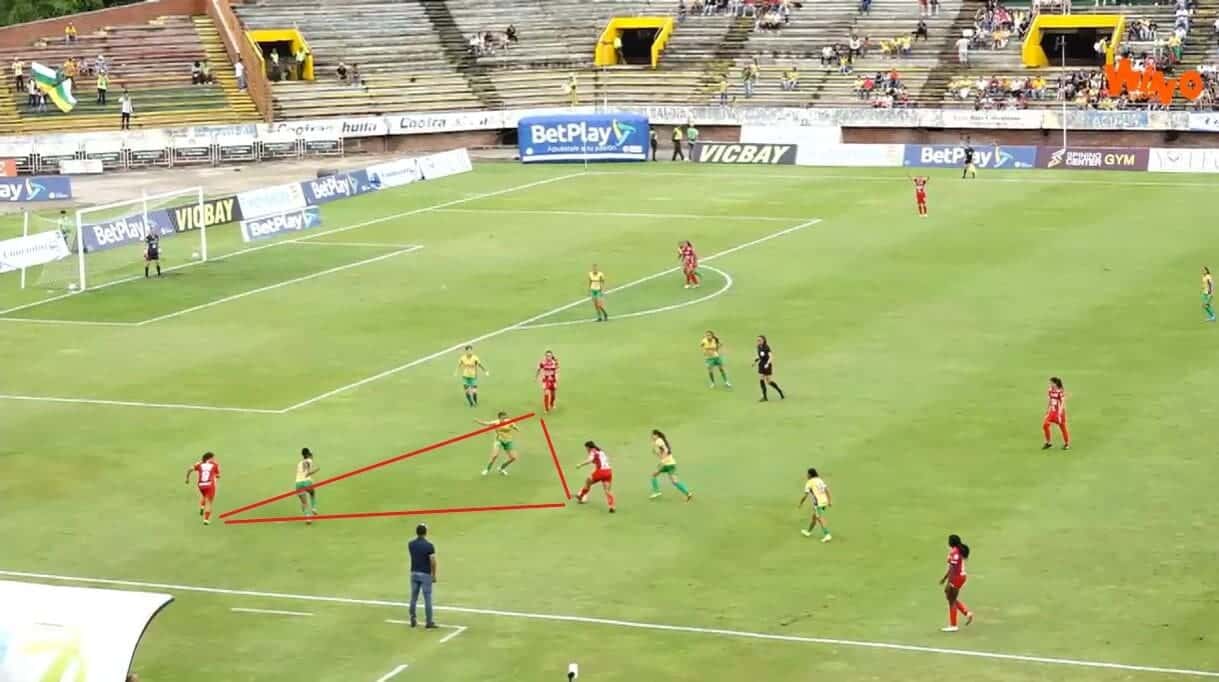
The fact that América have wing-backs also means that their wider attackers can cut infield much more and create numerical overloads in the central areas, which is another reason that they have been so potent in the final third, having averaged 2.7 goals per game.
However, there has been another benefit to this way of playing, because it has also allowed different members of the América squad to link up with each other in wider areas, with triangular structures like this one against Atlético Huila Femenino common to see in many of their performances.
The reason that they look to create these shapes is that it gives them a way of playing through opponents and transferring the ball into the spaces behind, enabling them to break opponents down who seek to sit back and play in a low block. In this case, the only reason that attacking midfielder Gabriela Rodríguez was able to take the ball almost into the goal area was because Sara Martínez and Usme teamed up to construct a series of quick one-touch passes to find her, and the fact that América have a 77.8% passing accuracy shows how they rarely gave the ball away in situations such as this.
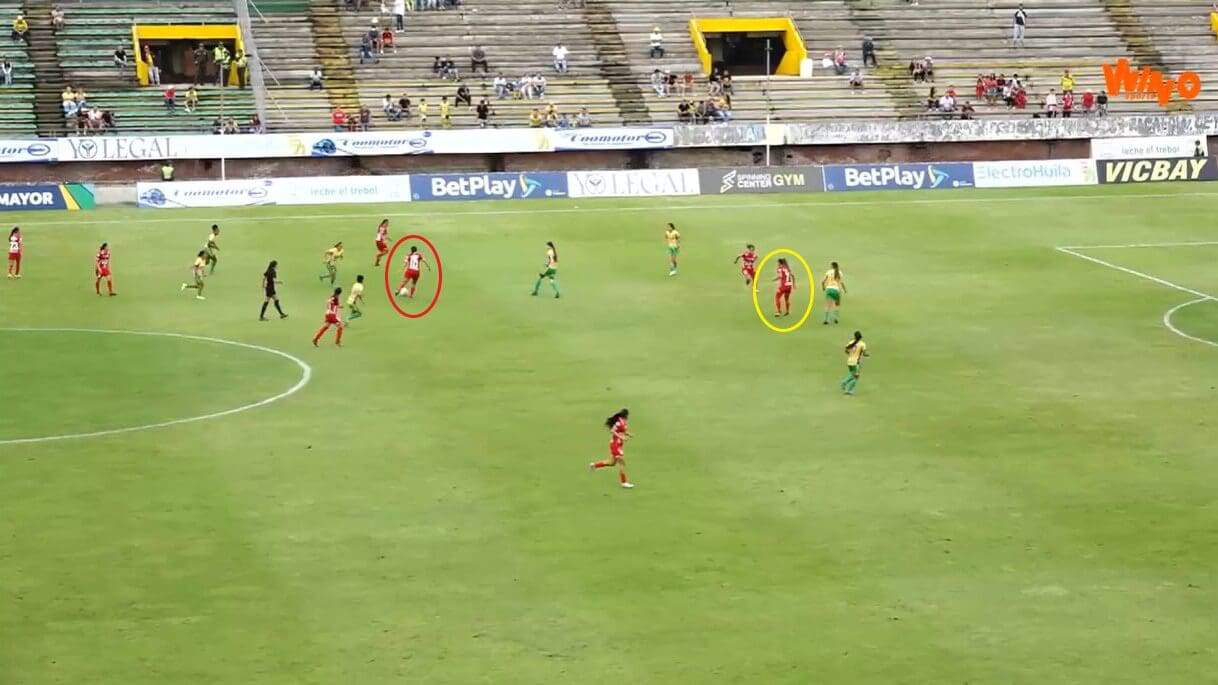
However, América’s attacking play is not all about how they use the ball, because another key aspect of it has been how they use themselves, and this is where positional rotation comes into the equation. Here, Usme has dropped back from the front line to take up a deeper role as she tries to help her teammates move the ball up the field, and this has led to another of the team’s Colombia internationals, Elexa Bahr, operating as a sole forward and needing to take on added attacking responsibility.
Some players might flounder at this point, but Bahr thrives in the role, with her finding the net on six occasions so far in 2023 (one of which came here), and that is why América can rotate players around and still pose a threat because the balance of the team and their ability to keep testing their opponents has not been lost through players moving into different areas of the field. However, they have given Huila, in this case, something new to deal with, and that shows why this aspect of their tactics has been key to their success this year.
Defence
The defensive side of things has been just as strong for América de Cali Femenino, with it clear in every game that they constantly work hard to make themselves tough to score against, and the fact that they have conceded just 11 times across the entire campaign (a total of 20 fixtures to date) indicates how robust they have been without the ball.
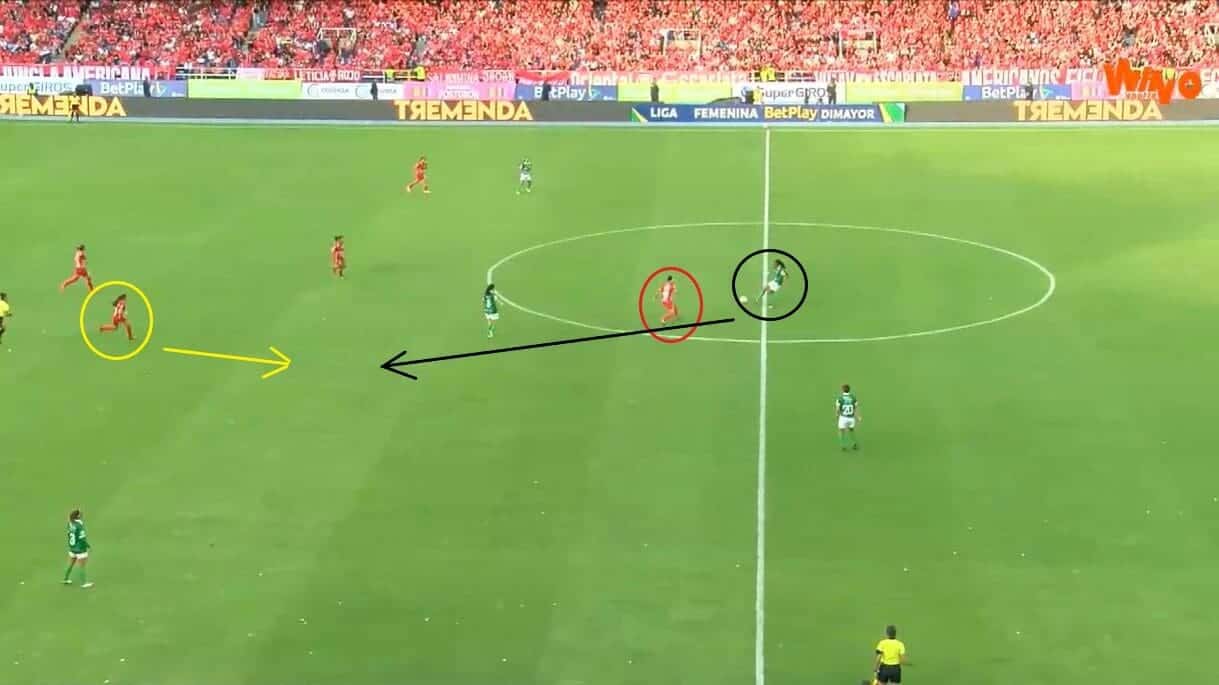
What is important to mention is that defending starts at the front for Hernández’s side, with those at the top of the field constantly looking to press and harass their opponents into making mistakes with the ball as they try to regain possession as rapidly as possible. In the match against city rivals Deportivo, this was particularly evident, with there being an undoubted desire to claim the local bragging rights in a derby which, in the men’s game at least, is ranked as one of Colombia’s fiercest and among the greatest in world football.
América’s press is generally carried out in the same way each time they instigate it, with one player pushing forward to force the error and others waiting in the wings to secure the ball once it goes loose. In this case, Wendy Bonilla is leading the charge and targets Stefanía Perlaza, knowing that the 17-year-old is less experienced and so will be more prone to giving the ball away under pressure, and that proves to be a good decision as Perlaza underhits her forward pass and allows Venezuela international Leury Basanta to gain possession for the play-off finalists.
At that point, América had momentum and could advance forwards at speed, with them getting into Deportivo’s goal area from this charge, and the fact that they have ended 42.9% of their counterattacks with a shot on goal shows just how big a threat they pose when fired up in this way.
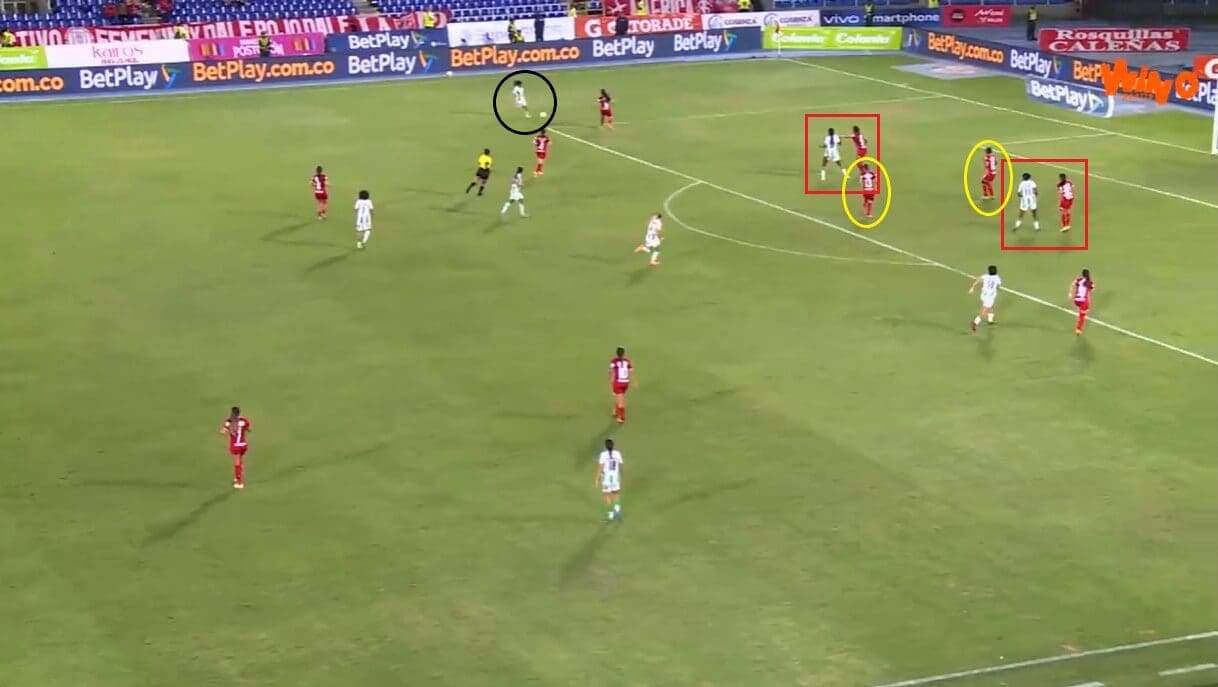
Executing and timing that press showed great precision and organisation, and those are themes that continue when looking at how América set up to protect their goal once opponents advance into their third.
As with the attacking side of things, there is a significant hybrid flavour to their approach to these situations, with them once again taking the best of two styles of defending and combining them to form their own brand. In this case, it’s a mix of zonal and player-to-player marking, with them recognising the threat on the far side of the field and also the fact that there are two targets for the ball to travel to inside their goal area. To protect against both and the possibility of the ball travelling into another space, they have four players back and use two to mark the attackers whilst keeping the other two free to either drop back or push forward, depending on where Atlético Nacional Femenino’s cross is aimed.
As a result, it becomes more difficult for the attacking side to make the most of their opportunity, because there is always a distinct probability that they will concede possession as soon as they try to move it into the middle, and that was the case here as América’s Daniela Arias won the ball before a Nacional player and then followed up by blocking the next attempt to shoot at goal.
This does lead to frustration by opponents, and it is unsurprising therefore that so many of these chances end with a shot from distance which doesn’t trouble América (this one concluded with Daniela Montoya firing over), and only 28.7% of shots against them have been on target. Therefore, when considering why América have been so tough to break down when without the ball, and why they have only conceded 0.55 goals per game, having this hybrid mentality is undoubtedly contributory.
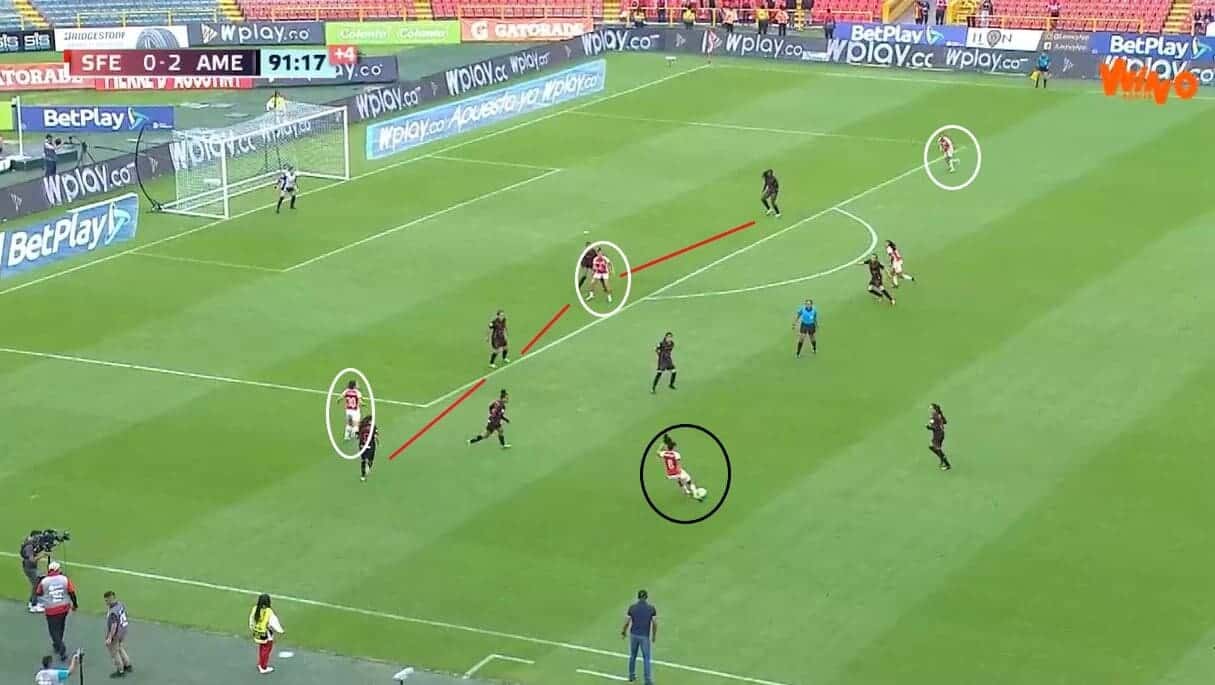
However, it is not their only way of defending, and that is also important to note because any team who wants to keep clean sheets needs to know what to do when they don’t have time to set up in their desired formation. For América, there have been occasions when they have needed to take a more simplistic approach to their setup, and the game against Santa Fe, who are based in the capital of Bogotá, was one of those.
Here, it was all about marshalling and containing the attackers, with América looking to set up in a line and stretch out as far as they could, but without leaving spaces open between them that could be exploited. By doing so, they have now made it difficult for Paola García to find a teammate with her delivery, as the central player is being marked tightly, the player nearest has been cut off by the América players between them and the player on the far side is too far away, and the result is that the ball travels behind the defensive line and is gathered harmlessly by goalkeeper Natalia Giraldo.
As with their attacking play, the key headline in this section of the analysis is that América want to bring together different elements of multiple styles in order to form their own way of defending, but they also recognise the need to have a simpler way of playing when they don’t have time to set up in their preferred structure, and having that balance is why they have been so effective out of possession as the season has gone on.
Key Players
Whilst there is little doubt that being successful in the way that América de Cali Femenino have been comes down to the whole team working together, there are a few players who have stood out as essential cogs in the machine, and some are the types of players that could attract notice from abroad in the same way that Caicedo did just a few months ago.

The first is Diana Ospina, who plays a key role as the lynchpin in the midfield, with her constantly dictating both the pace and direction of América’s play as they try to build attacks. At the age of 34, it seems unlikely that a move to a big club will materialise for her, but that doesn’t matter as América’s fans will be very happy to keep the Colombia international at the club, given her importance to their whole on-field identity.
As this situation demonstrates, her key strength is her spatial awareness, with her possessing a knack of making the right passes at the right time and enabling her teammates to play on the front foot with a greater chance of scoring. To ensure that she finds the right route through, it is common to see her probing the gaps ahead of her when faced with low blocks, such as the one instigated by La Equidad Femenino here, and, in this case, her through ball towards Mariana Zamorano was the third attempt to break through the defensive line, but it was the one that eventually led to a shot on goal.
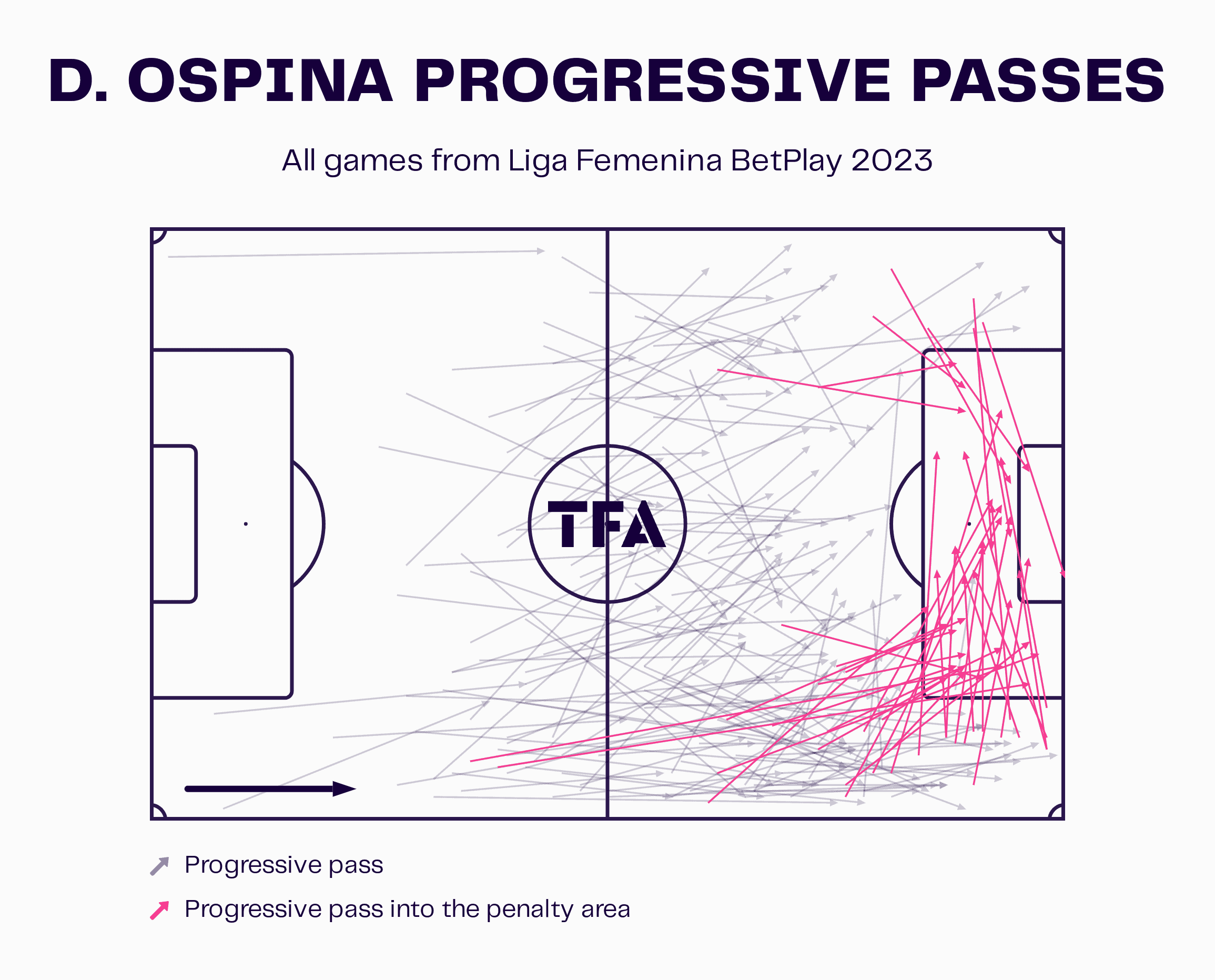
The fact that she has picked up five assists this season demonstrates how effective she is when distributing from areas like this, but it is her ability to constantly make progressive passes that América have really depended on, with this graphic showing how often she plays the ball forwards, and the length of these passes is important to note as that fits in with the aforementioned hybrid style that Hernández has implemented when his team is in transition.
However, it is also worth pointing out the variety of areas that she has made these passes from, as that shows how much she drifts into central and wide areas during games, and that again shows how she fits into América’s game plan in that it indicates her role in their fluid positional rotations, and there is little doubt that she has been a vital player in their progression to another domestic finals stage.
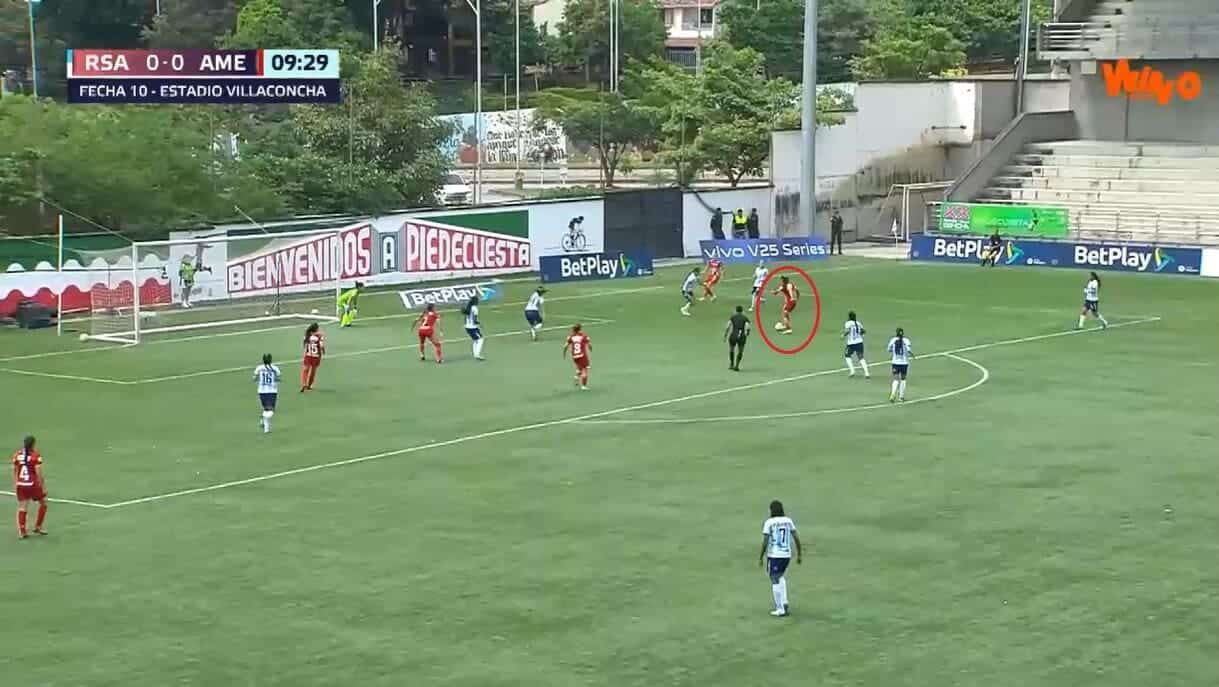
The player that she was passing to in that game, Zamorano, can certainly be included in the category of young talents who have the ability to go all the way (along with Bonilla), and she is the most likely player in the América squad to follow Caicedo into one of the world’s major women’s leagues.
Ever since making her debut for the club back in 2021, the 20-year-old has been one of her side’s biggest goal threats, and she has already scored seven times in the current campaign. What helps her to pose so many questions is her ability to locate space between opposing lines, and that is clear here as she pulls back slightly from the Real Santander Femenino defenders to give Mariana Muñoz (who is another really exciting young player) an easy pass into the middle, with Zamorano controlling and then finding the bottom corner of the net.
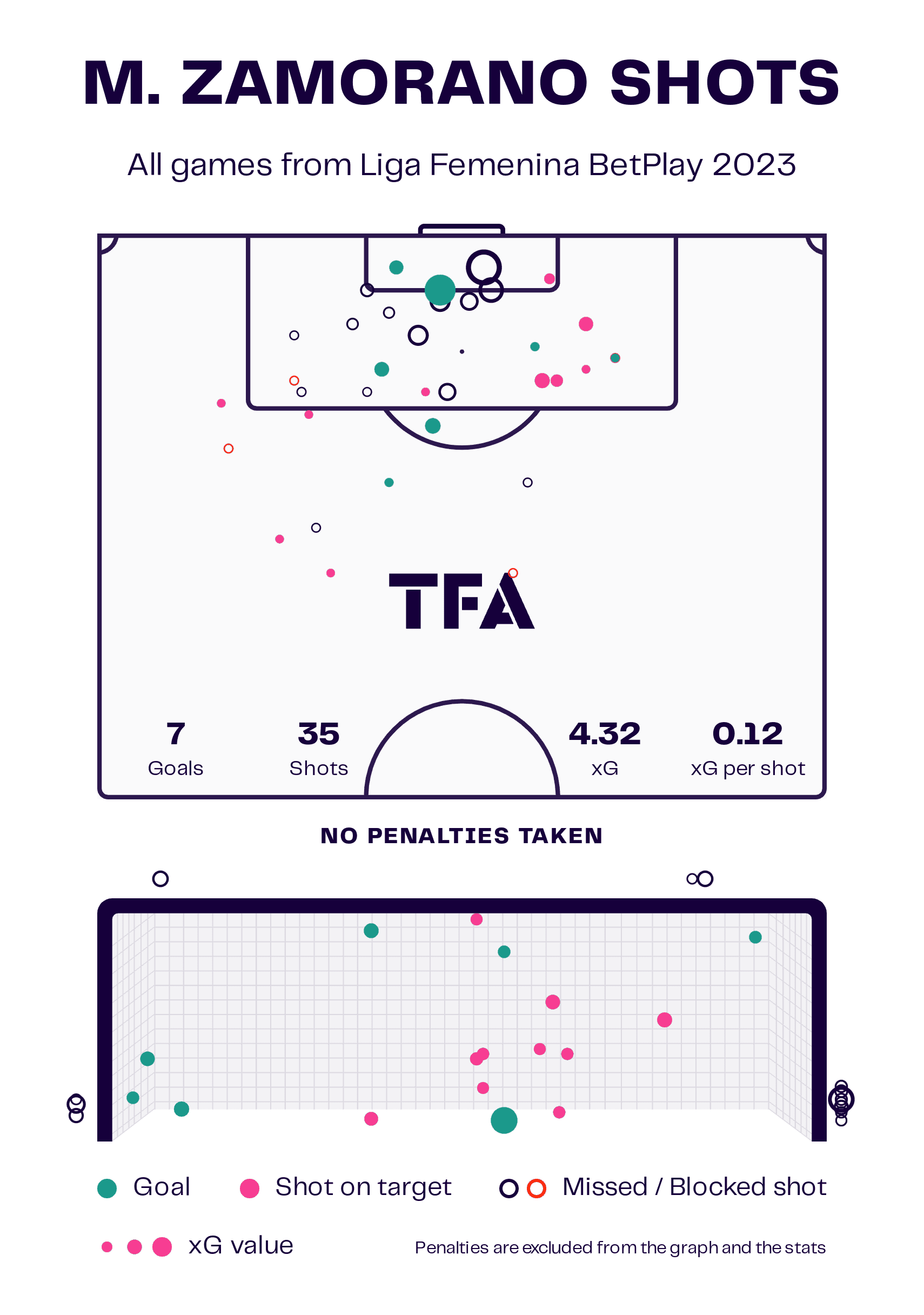
As this graphic indicates, scoring from these areas is a constant feature of Zamorano’s game, and the fact that she tests opposing goalkeepers from deeper areas as well as from close in, and yet has still managed to get 48.6% of her shots on target, means that there are several layers to her game and she is not just a one-dimensional attacker who can only help her team in one area of the pitch. It also indicates her positional versatility too, which will really benefit her as her career goes on, and there is little doubt that she has all the key ingredients necessary for a long and successful career in the game.
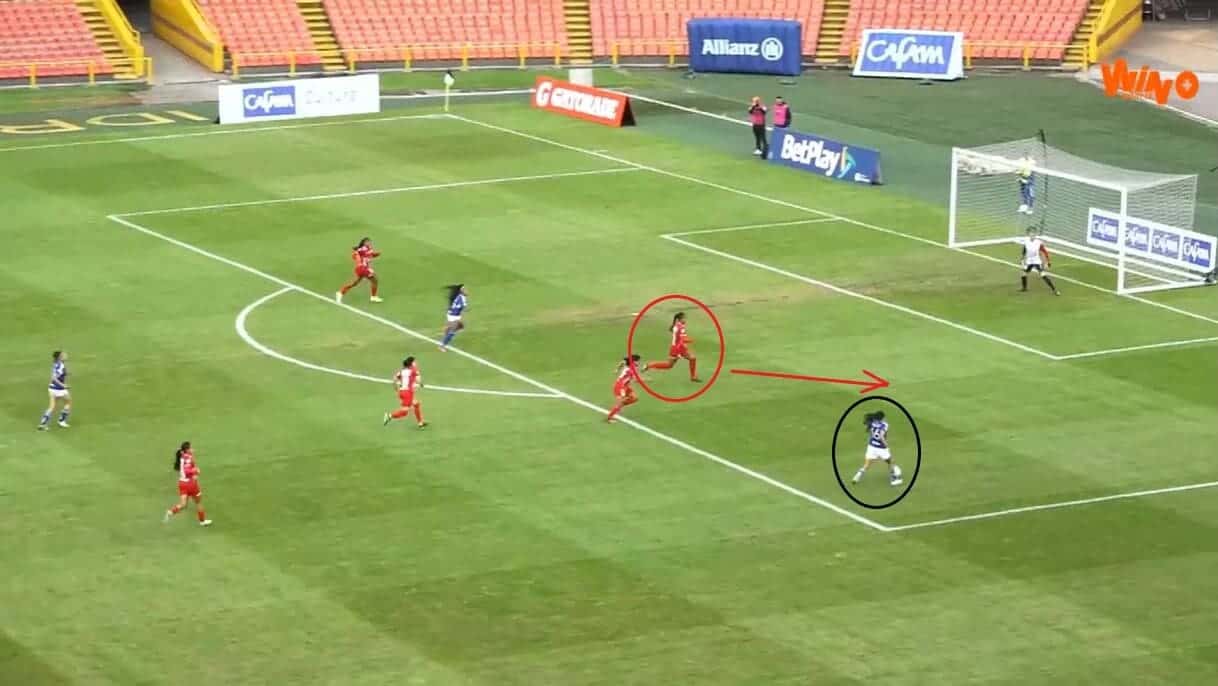
The final player to look at is Arias, and it has already been mentioned in the scout report that the Colombia defender is a key part of América’s tactics out of possession. In this case, Millonarios Femenino had the tools to test América’s defensive resolve and were continually stringing together intelligent passes, and the regular season champions did need to work hard in this game to prevent Millonarios from having too many chances to test Giraldo.
One of the players who worked hard to stop shots being taken was Arias, and she was her side’s leader and organiser at the back, with her reading the play ahead of those in her vicinity and putting her body on the line to limit the damage that the attackers could do. In this case, Lina Gómez Medina has been played through by Gabriela Camargo and is about to shoot at goal, but has been tackled well by Arias, and, even though this encounter ended up as one of América’s only two defeats of the season, the defender stood out for her endeavour and character throughout.
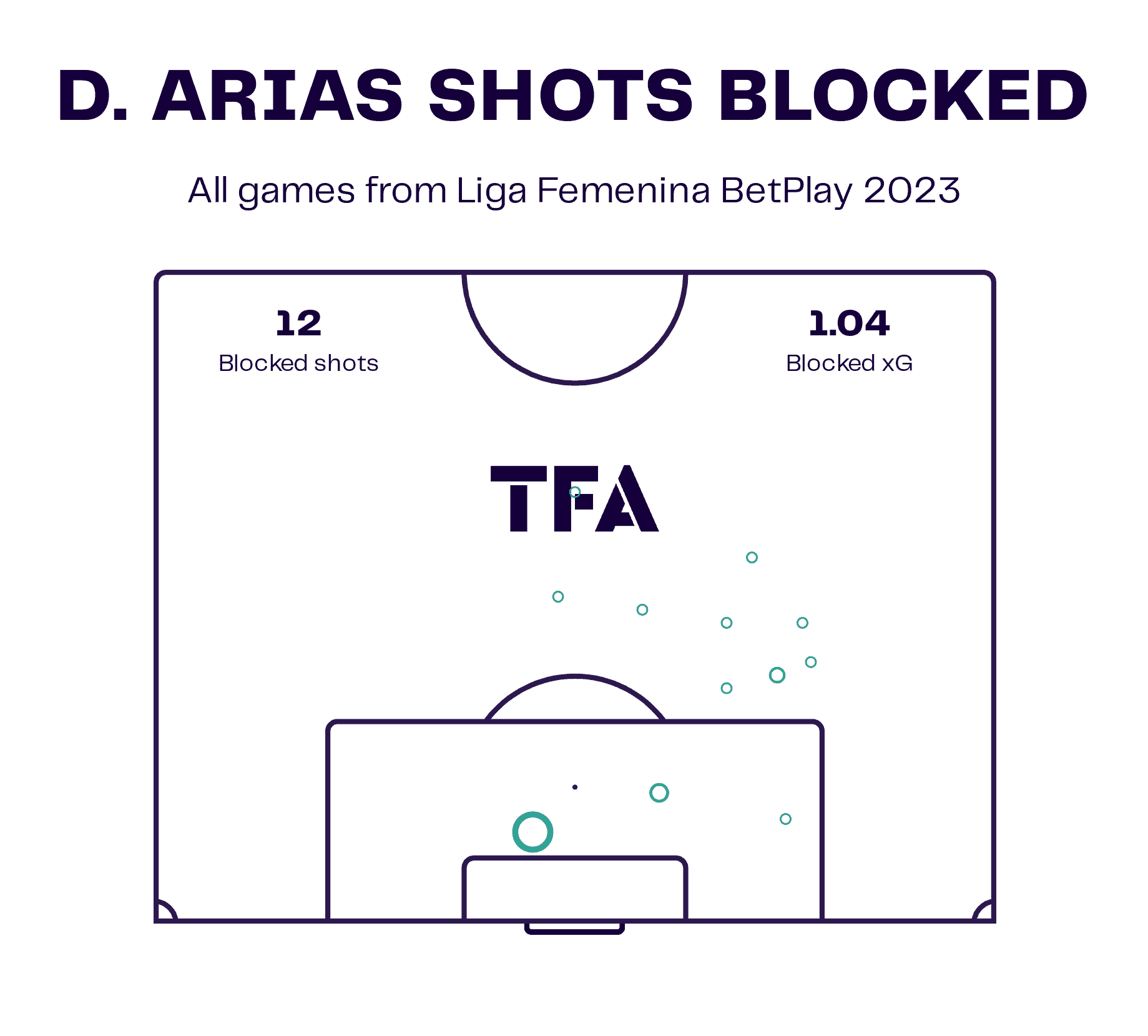
Making vital interventions in these areas has been a key component of Arias’ game for a long time, and, whilst she is known for her ball-playing abilities (she has a 79.9% passing accuracy this season), this graphic shows that she can do the less glamorous aspects of the role as well, with her hovering around the six yard line more often than not and winning 69.2% of her defensive duels and 68.1% of her aerial duels, as well as averaging 5.37 interceptions per match.
At the age of 28, there is still a chance that she could be picked up by a team in another country, especially with some in need of a tough-tackling defender who can provide additional leadership and security without the ball, and so it could be worth seeing if a move materialises for her either after the World Cup or in the future.
Conclusion
In conclusion, this tactical analysis has looked in detail at Colombian giants América de Cali Femenino, who have been one of the South American nation’s strongest teams historically and who will attempt over the coming weekends to seal a third title and overcome the “great weight on [the team’s] shoulders”, as some media outlets have stated, to become the most successful team in Liga Femenina history.
What has made them such an exceptional team this time around is their almost unique way of playing, with it always difficult to break teams down who either defend zonally or who adopt a player-to-player style, and always tricky to defend against long direct passes and transitions through the thirds. However, to face a team that combine the best aspects of all of them is almost unprecedented and means that a specific game plan is needed, and, as América’s form suggests, not many have found that formula.
As mentioned at the beginning of the analysis, Brazil and Argentina have undoubtedly been the dominant forces when it comes to producing top talent on the South American continent. However, Colombia are definitely closing that gap, and the attention that has been given to Caicedo following her move to the Spanish capital shows that there are hidden gems in the country’s footballing system if external clubs know where to look. When it comes to which clubs they should be watching, América are undoubtedly near the top of the list.




Comments